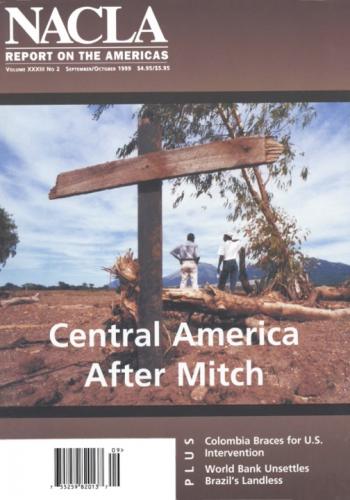Report
The wind moved suddenly, shaking the branches of the mango trees. Just a few days before, a wave of humidity—different from the salty air of the ocean—had settled over El Bajo Lempa, the area surrounding the River Lempa in Ciudad Romero, in southeastern El Salvador.
On November 16, 1998, 12-year-old Bernardo González went for a swim in a pond near Puerto Viejo, in north-central Nicaragua. The boy's outing proved fatal.
In the aftermath of Hurricane Mitch, business interests—both domestic and foreign—sought to use the crisis to advance their own interests. Perhaps the most illustrative example was that of the Tela Railroad Company, a subsidiary of the Cincinnati-based Chiquita Brands International (the corporate descendent of the infamous United Fruit Company).
The winding Choluteca River connects the wide and fertile valleys of Honduras' central mountains with the southern mountains along the Pacific slope. This watershed links Tegucigalpa, once a tiny colonial mining town in the central mountains and now a bustling capital city of 800,000 inhabitants, to Choluteca, the major city on the southern coastal plain with a population of over 110,000.
A hurricane or natural disaster hits two equally populated territories with the same force. Why is it that the human damage can be so much higher in one place than in another? And why does it take more time to recover in one than in the other?
Though the mainstream U. S. media stopped reporting the devastation left by Hurricane Mitch a few weeks after the storm had passed, the U.S. government continued to implement a multifaceted program of direct aid, debt relief and temporary relief for immigrants from Honduras and Nicaragua.
When the Berrinche hill collapsed into the Choluteca River in downtown Tegucigalpa, it brought down scores of houses. Families in the Soto neighborhood had clung to the steep hillside with the tenacity of the poor who had come to the city seeking a better life.
The survivors of last October's devastation in Honduras and Nicaragua have lived through a double hurricane: a four-day meteorological event named Mitch and a social/ecological disaster compounded by debt and economic "adjustment" many years in the making.
While President Aleman has tried to pitch debt forgiveness as a solution to Nicaragua's problems, debt relief under IMF guidelines implies more fiscal austerity. And there are no guarantees as to how freed-up funds will be spent.

